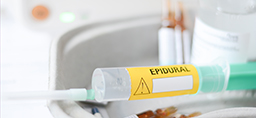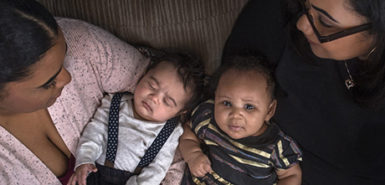
Some women might wonder in silence—even embarrassment—about why their tummy still looks pregnant months after giving birth.
Thanks to recent awareness and heightened education, many moms know the words diastasis recti, which could be the cause of their postpartum belly.
What they might not know is what to do about it.
Sara DeNolf, MD, an OB-GYN for Spectrum Health Medical Group – Mid Towne, said many patients ask her at their six-week postpartum check-up if they have diastasis recti, a separation between the two sides of the rectus abdominis muscle, also known as the six-pack muscle.
The fact is, nearly all patients still have it six weeks after pregnancy. The question is whether or not it will resolve on its own.
Rescued by PT
When diastasis recti doesn’t resolve on its own, Dr. DeNolf has one message for her patients: “Physical therapy. Do not hesitate. Run. Call your OB-GYN and ask for a pelvic floor physical therapist.”
Women in West Michigan are particularly fortunate because there are a number of physical therapists who specialize in pelvic floor rehabilitation, which includes treatment of diastasis recti, Dr. DeNolf said.
One of those physical therapists is Emilee Van Hoven, with Spectrum Health Rehabilitation.
“I think that so often after having a baby you’re not focused on yourself,” Van Hoven said. “The last thing you’re concerned about is, ‘Why do I have this gap in my abdomen that I didn’t have before?’ It can easily fall to the back burner and then you wonder, ‘Have I let it go too long?’
“I love seeing women who are not only able to make their abs look better, but to make them function better and get back to what they love doing,” she said.
With diastasis recti, the six-pack muscle separates in the middle at the linea alba during pregnancy, allowing the belly to expand to make room for baby.
Pregnancy hormones help relax the connective tissue and aid the separation, so when hormone levels return to normal after baby is born, the separation sometimes comes back together on its own. Other times, years can pass and a woman can still have a gap that probably won’t heal without treatment.
Moms who have had several pregnancies or given birth to multiples are at higher risk for diastasi recti. Those who give birth at age 35 or older are also at increased risk.
Diastasi recti looks like a cone or ridge down the middle of your belly, Van Hoven said.
Women can test to see if they have it by lying down flat, bending their knees up and placing their hand on their belly, fingers pointed to the ground. If you press down with your fingers and feel a gap, that’s diastasis recti.
Mind the gap
Believe it or not, it’s not the actual gap that physical therapists are concerned about. It’s the tension and strength across that gap. The goal of therapy is not to close the gap, but to make sure the muscles can work across the gap and support a woman’s core, Van Hoven said.
“There’s a misconception that it’s all about the separation and the one muscle. But truly it’s about the whole system, and you cannot address it in isolation,” she said.
She encourages women to think about it this way: Your core is a pop can. The top is your diaphragm, the sides are your abdominal and back muscles, and the bottom is your pelvic floor.
“We need to make sure all parts of the pop can are functioning well,” she said.
And if they’re not, it can lead to back, hip and pelvic pain, breathing problems and even incontinence.
Make time for healing
If you have diastasis recti and it’s causing pain or other issues, you may need to avoid crunches, situps, leg lifts and other abdominal exercises, Van Hoven said. Instead, see a physical therapist who can evaluate the condition and recommend appropriate exercises for healing.
The physical therapist may also use some hands-on therapy to help restore normal tissue length. Often after delivery, Van Hoven said, a mom’s muscles are tight in the back and very loose in the front.
The therapist might also use a product called kinesiology tape to offer support while mom heals.
When physical therapy doesn’t work, women can consult a plastic surgeon to discuss whether surgery is needed, Dr. DeNolf said.
But most of the time, physical therapy works. Because of that, she’s quick to encourage moms to make the time to do it.
“Often the physical therapists can give them exercises they can do on their own at home,” Dr. DeNolf said. “Everyone who has this is a busy mom, and learning how to treat yourself at home is empowering.”
 /a>
/a>
 /a>
/a>
 /a>
/a>